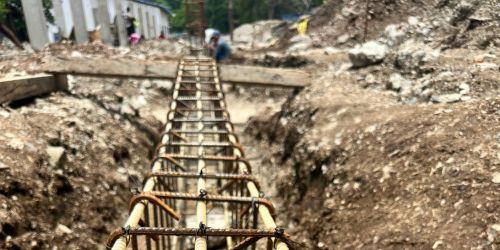In modern construction, the demand for innovative and sustainable materials is increasing. One such material that has garnered significant attention is GFRP bars (Glass Fiber Reinforced Polymer bars). Glass fiber-reinforced polymer (GFRP) has demonstrated great potential in civil engineering. It offers several advantageous properties comparing with other traditional reinforcing materials. One of the distinguishing properties of GFRP bars is the unprecedented durability when subjected to aggressive environment.
What are GFRP Bars?
Before diving into the advantages, it’s important to understand what GFRP rebar are. GFRP bars are reinforcement bars made from a combination of glass fibers and polymer resins. These bars are used in place of traditional steel rebar to reinforce concrete structures. Initially, it was the lack of validated data that delayed the worldwide acceptance of GFRP as the ideal environment-resistant and durable material for structural concrete applications.
- Corrosion Resistance
The use of GFRP as an external reinforcement has increased considerably over the past few years. The rapid deterioration of concrete infrastructure is largely associated with corrosion and ruptured steel.Initially, it was the lack of validated data that delayed the worldwide acceptance of GFRP as the ideal environment-resistant and durable material for structural concrete applications.
- Lightweight and Easy to Handle
Because of the worldwide corrosion issue and the inability of steel to fight corrosive agents, civil engineers now have shown faith in GFRP as a step to eliminate corrosion-related issues. The non-corrosive nature of fiberglass bars help engineers restore the integrity of deteriorated concrete structures.
- High Strength-to-Weight Ratio
In rehabilitation applications, fiber-reinforced polymers are used to confine concrete, enhance the shearing capacity, and flexural strength of a concrete member. FRP is commonly used for repair and restoration of structurally deficient concrete members.
- Non-Magnetic Properties
Unlike steel, GFRP bars do not conduct electricity or produce a magnetic field. This property is particularly useful in specific construction applications where magnetic interference needs to be avoided, such as in electromagnetic environments, electrical substations, or hospital buildings with sensitive equipment. Additionally, GFRP bars’ non-conductive nature reduces the risk of electric shock, providing an extra layer of safety for construction workers.
- Resistance to Chemicals
Another standout feature of GFRP bars is their resistance to a wide range of chemicals, including acids, alkalis, and salts. This makes them highly suitable for use in aggressive environments such as wastewater treatment plants, chemical processing facilities, and marine structures. The ability to withstand chemical attacks ensures the longevity and structural integrity of the concrete in which GFRP bars are embedded, contributing to the overall durability of the building.
- Enhanced Durability
Due to their corrosion resistance, lightweight nature, and high strength, GFRP bars significantly enhance the overall durability of concrete structures. Structures reinforced with GFRP bars can withstand harsh weather conditions, temperature fluctuations, and other environmental stresses. This means fewer repairs, lower maintenance costs, and a longer lifespan for the building.
- Environmental Sustainability
The environmental impact of construction materials is a growing concern in today’s world, and GFRP bars stand out as an environmentally friendly option. These bars are made from materials that are more sustainable compared to traditional steel, and their use in construction reduces the need for frequent repairs and replacements. Additionally, the lightweight nature of GFRP bars means lower energy consumption during transportation and installation, contributing to a smaller carbon footprint for the construction project.
- Improved Thermal Insulation
GFRP bars are also known for their ability to act as a thermal insulator. Unlike steel, which can conduct heat, GFRP bars help reduce heat flow within the structure, making buildings more energy-efficient. This can be particularly advantageous in structures located in areas with extreme temperatures, where reducing heat loss or gain is essential for maintaining a comfortable indoor environment.
- Design Flexibility
The use of GFRP bars in construction provides engineers with greater flexibility in design. Because GFRP bars are lightweight and easy to manipulate, they can be shaped and customized to meet the specific needs of a project. This allows for more innovative and complex structural designs that might be difficult to achieve with traditional steel rebar. The ability to create unique designs and solutions is one of the reasons why GFRP bars are increasingly being used in modern construction projects.
- Cost-Effectiveness in the Long Run
While the initial cost of GFRP bars may be higher than that of traditional steel reinforcement, the long-term benefits outweigh the initial investment. The corrosion resistance, durability, and reduced maintenance costs of GFRP bars result in significant savings over the lifespan of the structure. Furthermore, the reduced weight of GFRP bars can lower labor and transportation costs, making them a cost-effective choice for many construction projects.
- Reduced Risk of Cracking
The flexibility of GFRP bars allows them to absorb more stress compared to traditional steel bars, reducing the risk of cracking in concrete. This is particularly beneficial in areas where buildings may experience vibrations, seismic activity, or fluctuating loads. The ability of GFRP bars to accommodate these stresses without cracking ensures that the concrete remains intact, enhancing the structural stability of the building.
Conclusion
As the construction industry continues to evolve, the adoption of GFRP bars represents a significant step forward in creating more durable, sustainable, and cost-effective structures. With their corrosion resistance, lightweight nature, and exceptional strength, GFRP bars offer a wide range of benefits that make them an ideal choice for modern construction projects. Whether it’s for bridges, high-rise buildings, or marine structures, GFRP bars are proving to be an essential material for the future of construction.Bottom of Form
